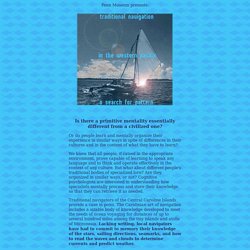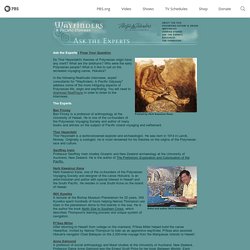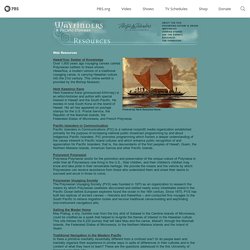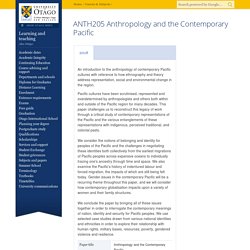

Australia and Oceania: Human Geography. Asian Pacific American Center. The John C. and Susan L. Huntington Photographic Archive of Buddhist and Asian Art. National Geographic Magazine - NGM.com. By Roff Smith Much of the thrill of venturing to the far side of the world rests on the romance of difference.

So one feels a certain sympathy for Captain James Cook on the day in 1778 that he "discovered" Hawaii. Then on his third expedition to the Pacific, the British navigator had explored scores of islands across the breadth of the sea, from lush New Zealand to the lonely wastes of Easter Island. This latest voyage had taken him thousands of miles north from the Society Islands to an archipelago so remote that even the old Polynesians back on Tahiti knew nothing about it.
Imagine Cook's surprise, then, when the natives of Hawaii came paddling out in their canoes and greeted him in a familiar tongue, one he had heard on virtually every mote of inhabited land he had visited. Answers have been slow in coming. At the same time, other pieces of this human puzzle are turning up in unlikely places. Oceania, 8000–2000 B.C. Australia and Oceania: c. 50 million years ago - 2007.
Lesson Plans and Curriculum. Introduction to Southeast Asia. By Barbara Watson Andaya Southeast Asia consists of eleven countries that reach from eastern India to China, and is generally divided into “mainland” and “island” zones. The mainland (Burma, Thailand, Laos, Cambodia, and Vietnam) is actually an extension of the Asian continent. Muslims can be found in all mainland countries, but the most significant populations are in southern Thailand and western Burma (Arakan). Centre for Southeast Asia Research (CSEAR) Books - Department of Pacific Affairs - ANU.
The Journal of Pacific History: Vol 52, No 3. Traditional Navigation in the Western Pacific @ University of Pennsylvania Museum of Archaeology and Anthropology. Is there a primitive mentality essentially different from a civilized one?

Or do people learn and mentally organize their experience in similar ways in spite of differences in their cultures and in the content of what they have to learn? We know that all people, if raised in the appropriate environment, prove capable of learning to speak any language and to think and operate effectively in the context of any culture. But what about different people's traditional bodies of specialized lore? Are they organized in similar ways, or not? Cognitive psychologists are interested in understanding how specialists mentally process and store their knowledge so that they can retrieve it as needed. Traditional navigators of the Central Caroline Islands provide a case in point.
Penn Museum | 3260 South Street, Philadelphia, PA 19104 | www.penn.museum ©1997. Home - Pacific Islanders in Communications. Wayfinders : Ask the Experts. Ask the Experts | Pose Your Question Do Thor Heyerdahl's theories of Polynesian origin have any merit?

What are the doldrums? Who were the early Polynesian people? What is it like to sail on the recreated voyaging canoe, Hokule'a? Wayfinders : Web Resources. Web Resources Hawai'iloa: Seeker of Knowledge Over 1,600 years ago voyaging canoes carried Polynesian settlers to these shores.

Hawai'iloa, a modern version of a traditional voyaging canoe, is carrying Hawaiian culture into the 21st century. This online exhibit is provided by the Bishop Museum. Herb Kawainui Kane Herb Kawainui Kane (pronounced KAH-ney) is an artist-historian and author with special interest in Hawai'i and the South Pacific. Asian Pacific American Heritage Month - For Teachers. Teaching Asian and Pacific Islander Heritage, Grades 9-12. By Phil Nast, retired middle school teacher and freelance writer Found In: Arts, Language Arts, Science, Social Studies, 9-12 Lesson Plans The Japanese American InternmentHow Young People Saw It Students in grades K-12 use primary and secondary sources to learn of the experiences of children and teens in World War II internment camps.

Creating Hawaii Students in grades K-12 learn about Hawaii’s history and culture by exploring the Smithsonian exhibition, Creating Hawai’i. Lessons of the Indian Epics: Following the Dharma Students in grades 9-12 explore Hindu culture by examining the characters of the Ramayana, and the choices they make.
Haven't I Seen You Somewhere Before? Activities Asian Art Museum: Education Search region for K-12 lessons & activities, artwork, video or background information. Wayfinders: The Game Learn the skills of wayfinding and see if you can sail “ke,” an ancient Polynesian vessel across the sea. Carving a Bullroarer Illustrated steps for carving a bullroarer. Art. The best of Asian art at the tip of your fingers for use in the classroom or at home.
Asian-Pacific Heritage Month. ANTH205 Anthropology and the Contemporary Pacific, University of Otago, New Zealand. An introduction to the anthropology of contemporary Pacific cultures with reference to how ethnography and theory address representation, social and environmental change in the region.

Pacific cultures have been scrutinised, represented and overdetermined by anthropologists and others both within and outside of the Pacific region for many decades. This paper challenges us to reconstruct this legacy of work through a critical study of contemporary representations of the Pacific and the various entanglements of these representations with indigenous, perceived traditional, and colonial pasts. We consider the notions of belonging and identity for peoples of the Pacific and the challenges in negotiating these identities both collectively from the earliest migrations of Pacific peoples across expansive oceans to individually tracing one's ancestry through time and space. . ^ Top of page Prerequisite ANTH 103 or ANTH 105 or 54 points Schedule C.
NEW South Asia Network – A collaboration between the Universities of Nottingham, Edinburgh, and Warwick.